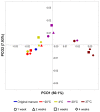Comparison of microbial communities in swine manure at various temperatures and storage times
- PMID: 29381907
- PMCID: PMC6043449
- DOI: 10.5713/ajas.17.0704
Comparison of microbial communities in swine manure at various temperatures and storage times
Abstract
Objective: This study was designed to investigate the effects of temperature and storage time on the evolution of bacterial communities in swine manure.
Methods: Manure was stored at -20°C, 4°C, 20°C, or 37°C and sampled at 7-day intervals over 28 days of storage, for a total of 5 time points. To assess the bacterial species present, 16S ribosomal RNA gene sequences were analyzed using pyrosequencing.
Results: After normalization, 113,934 sequence reads were obtained, with an average length of 466.6±4.4 bp. The diversity indices of the communities reduced as temperature and storage time increased, and the slopes of rarefaction curves decreased from the second week in samples stored at -20°C and 4°C. These results indicate that the richness of the bacterial community in the manure reduced as temperature and storage time increased. Firmicutes were the dominant phylum in all samples examined, ranging from 89.3% to 98.8% of total reads, followed by Actinobacteria, which accounted for 0.6% to 7.9%. A change in community composition was observed in samples stored at 37°C during the first 7 days, indicating that temperature plays an important role in determining the microbiota of swine manure. Clostridium, Turicibacter, Streptococcus, and Lactobacillus within Firmicutes, and Corynebacterium within Actinobacteria were the most dominant genera in fresh manure and all stored samples.
Conclusion: Based on our findings, we propose Clostridium as an indicator genus of swine manure decomposition in an anaerobic environment. The proportions of dominant genera changed in samples stored at 20°C and 37°C during the fourth week. Based on these results, it was concluded that the microbial communities of swine manure change rapidly as storage time and temperature increase.
Keywords: Heatmap Analysis; Microbial Community; Pyrosequencing; Swine Manure; UniFrac Distance; Firmicutes.
Conflict of interest statement
We certify that there is no conflict of interest with any financial organization regarding the material discussed in the manuscript.
Figures




References
-
- Mackie RI, Stroot PG, Varel VH. Biochemical identification and biological origin of key odor components in livestock waste. J Anim Sci. 1998;76:1331–42. - PubMed
-
- Switzenbaum MS, Giraldo-Gomez E, Hickey RF. Monitoring of the anaerobic methane fermentation process. Enzyme Microb Technol. 1990;12:722–30.
-
- Miller DN, Varel VH. Swine manure composition affects the biochemical origins, composition, and accumulation of odorous compounds. J Anim Sci. 2003;81:2131–8. - PubMed
-
- Clark RM, Geldreich EE, Fox KR, et al. Tracking a Salmonella serovar typhimurium outbreak in Gideon, Missouri: role of contaminant propagation modelling. J Water Supply Res Technol. 1996;45:171–83.
-
- Hurst CJ, Crawford RL, Knudsen GR, et al. Manual of environmental microbiology. second ed. Washington, DC, USA: ASM Press; 2002.
LinkOut - more resources
Full Text Sources
Other Literature Sources

